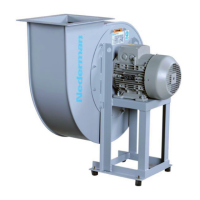NCFEN
28
6.3 Disassembly
WARNING! Risk of personal injury!
All the disassembly and reassembly operaons described below must only
be carried out by qualied and authorised personnel. For no reason whatsoever
must the operator or factory personnel carry out these operaons.
CAUTION!
All the disassembly and reassembly work must be carried out with the following condions:
• You must be absolutely certain that the fan is completely staonary (impeller at rest);
disconnect the electrical power at the main panel with the switch, lock the switch with a
padlock and hand the key to the head of maintenance.
• The working environment must be equipped with every tool necessary and must be free
of any hazards.
• Every piece to be reed must be thoroughly cleaned, degreased and lubricated as
necesasary before reng.
6.3.1 Intake nozzles
Undo the nozzle securing nuts from the fan housing. Slide out the nozzle.
6.3.2 Housing
With all orientable fans, the housing is secured to the frame by bolts. Simply undo the
securing nuts at the frame plate. With non-orientable fans with single-piece housings, the
housing cannot be disassembled. The housing in certain fan types may be divided into two
or more pieces, secured together by bolts.
6.3.3 Impeller
Remove the nozzle and, where possible, the fan housing. With single intake fans: remove
the screw together with the lock-ring and use a suitably sized extractor. We recommend
seng up a support for the impeller before extracng it completely. In any event, this
operaon must always be carried out with great care, avoiding any knocks that could alter
the balance of the impeller or deform it.
6.4 Flexible an-vibraon joints between the fan and ducng
Flexible joints located between the fan and exit and/or intake ducng must be checked
visually to ensure that they are undamaged and that no exible components have become
detached. If these joints must be dismantled for maintenance of the system and/or the
fan, they must be reassembled taking the precauons indicated for the rst assembly/
installaon.
6.5 Technical enclosures
Tightening torques for nuts and bolts
The ghtening torques M given in the table are applicable in the following condions:
• Hexagonal head UNI 5737 type screws, cylindrical head UNI 5931 and UNI 6107 type
screws, in normal condions in which they are supplied.
• Tightening torques must be applied slowly using a torque wrench.
While maintaining the same pre-load values, ghtening torques must be modied as
described below in the following cases:
• Increased by 5% for wide-head UNI 5712 screws.

